Tute M03 Arc 2d zsh Archive
- Copy the two .xyz (Creek_Centre_Line and Road_Crest_Survey) and rename the copy with .csv extension, i.e. Road_Crest_Survey.csv and Creek_Centre_Line.csv. A similar process could be used for tab delimited data, by saving the file as .txt.
- In ArcMap select File >>> Add Data >>> Add XY data from the menu items.
- Navigate to the Module_Data\Module_03\ folder.
- The .csv files should now be visible, select the Creek_Centre_Line.csv and select Add.
- In the Coordinate System of Input Coordinates section set the to Projected Coordinate Systems >> UTM >> WGS 1984 >> WGS 1984 UTM Zone 60S.prj. This is the same as our TUFLOW model.
- The file should have opened and have point objects down the creek. If it is not already open the DEM ensure that the points are being displayed onto of the DEM. The points should appear as per the image below, with the points having X, Y and Z attributes. The next step is to manipulate the shapefile into a TUFLOW file format.
- Export a copy of the Creek_Centre_Line_csv events into the TUFLOW\model\gis\ as 2d_zsh_M03_thalweg_001_P.shp. When prompted, do not open the new layer.
- Close the Creek_Centre_Line_csv file. The 2d Z Shape (2d_zsh) format requires the input data to be in the format outlined in the TUFLOW Manual. The first four columns of the table should contain the following attributes:
- Z
- dZ
- Shape_Width_or_dMax
- Shape_Options
- The file already has a "Z" attribute, but we need to add three additional fields, "dZ" (double), "Shape_Width_or_dMax"(double) and "Shape_Options" (character - length 20). To create these fields, open ArcCatalogue and then select then select the 2d_zsh_M03_thalweg_001_P.shp, right click on the file and select properties.
- In the Shapefile Properties dialogue, navigate to the Fields tab. Type dz into the Field Name underneath Z attribute and set the type to double. Create two mode fields Shape_Width_or_dMax (double) and Shape_Options (text length = 20), as per the image below:
Tip: In order to edit the fields, the file must not be open in ArcMap.
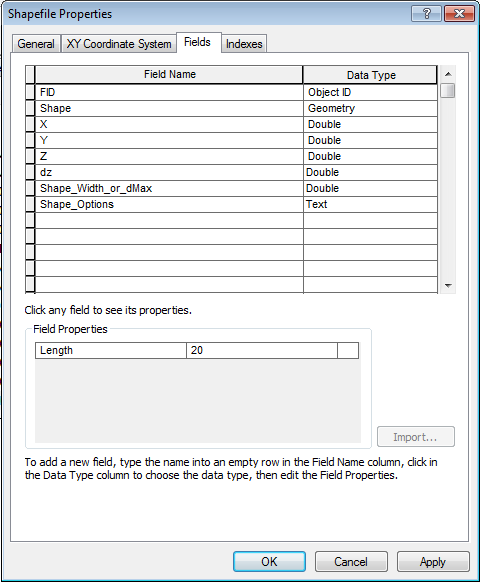
- We will manipulate the order of the fields in ArcMap. In ArcMap open the 2d_zsh_M03_thalweg_001_P.shp file. Make the layer editable and right click on the layer and select Open Attribute Table.
- In this dialogue the X and Z can be deleted. The X and Y data is stored in the geographic coordinates so is not required as a separate attribute.
- The data contains only points, no lines have been provided, we will need to digitise these. To do this we need to create a line file in the 2d_zsh format. Open the 2d_zsh_empty_L.shp file from the TUFLOW\model\gis\empty\ folder and export a copy as '2d_zsh_M03_thalweg_001_L.shp, close the template (empty) file and open the 2d_zsh_M03_thalweg_001_L file.
- We are going to create a line that joins the points together, this will need to snap to the points, make sure the points have snapping tool is enabled.
- Starting at the upstream end, create a polyline joining the points together. The line should snap to all of the points. Make sure to terminate the line and restart it upstream and downstream of the road embankments.
- Tip: If you make a mistake, continue and move the vertex later.
- For each of the lines, set the following attribute:
- Z = 99 (this won't be used as the elevation data is provided in the points)
- dZ = 0
- Shape_Width_or_dMax = 0
- Shape_Options = Min
The breakline to represent the creek centre line is now ready for input into TUFLOW.
- Repeat the process described above:
- Import the Road_Crest_Survey.xyz and create a new file called 2d_zsh_M03_Rd_Crest_001_P in the TUFLOW\model\gis\ directory;
- Modify the table structure to match the 2d_zsh format; and
- Create a new line layer from the 2d_zsh_empty_L.shp empty file named 2d_zsh_M03_Rd_Crest_001_L in the TUFLOW\model\gis\ directory;
- Digitise three lines, one for each road, as per the image below.
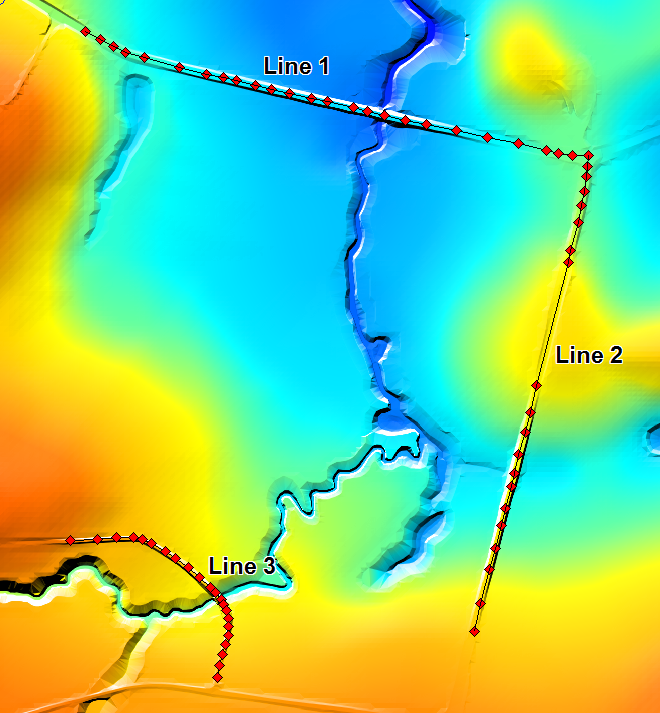
- On the lines shown above, enter the following attributes:
GIS Attribute Line 1 Line 2 Line 3 Z 99 99 99 dZ 0 0 0 Shape_Width_or_dMax 5 0 0 Shape_Options MAX MAX MAX As per the creek line above, the elevations are associated with the points and a dummy value of 99 is used on the line (the actual value is unimportant). If no points are in the layer, the elevation on the line object is used, i.e. the elevation along the line does not vary.
As explained in the TUFLOW Manual, for a line object the Shape_Width_or_dMax, controls the width of the breakline in metres. Depending on the cell size the following methods of application are used:
- Shape_Width_or_dMax = 0 - a "thin" breakline is used, only elevations on the cell side are modified (no change in storage);
- Shape_Width_or_dMax less than or equal to 1.5 times the cell size - a line of whole cells are modified (a "thick" breakline); or
- Shape_Width_or_dMax greater the 1.5 times the cell size - a "wide" breakline, elevations in multiple cells are modified. Any Zpts within a distance of half the Shape_Width_or_dMax are modified.
For the tutorial model a cell size of 5m is used, therefore, line 1 will be a "thick" formulation and line 2 and line 3 will be using a "thin" breakline. Later in the module we will looking at the check files to review which Zpts are modified.
Introduction
In this page, we import data from text file format into an ArcMap file. Once the data is in ArcMap format we will manipulate into a TUFLOW 2d Z Shape (2d_zsh) format ready for input into TUFLOW.
Method
Two separate sets of data have been provided in the \Module_Data\Module_03\. These are simple text files with the .xyz extension, as the name suggest these contain coordinates in a x, y and z format. In this case they are comma separated. For ArcMap to recognise an comma separated value file it must have the extension .csv.
Importing Text Data
The first step is to import that data into ArcMap, to do this:
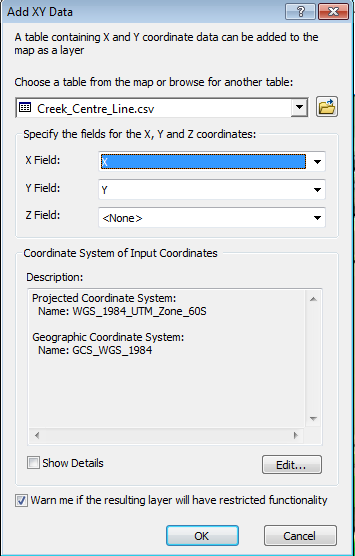
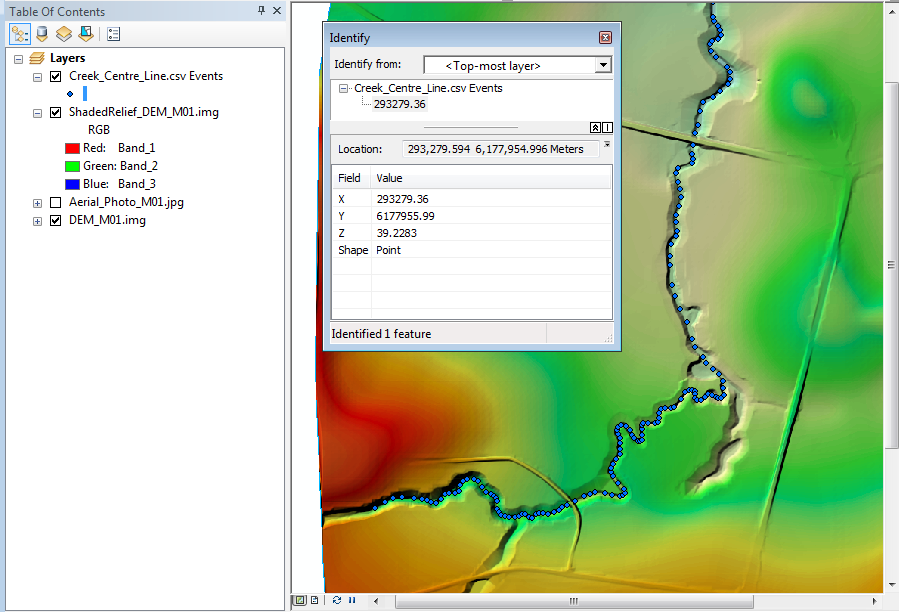
2d Z Shape Format
Note: TUFLOW actually uses the order of the attributes and not the file name when reading a file. The names are therefore not case sensitive and do not actually have to match, for example the third attribute "Shape_Width_or_dMax" can be truncated to "Shape_Width".
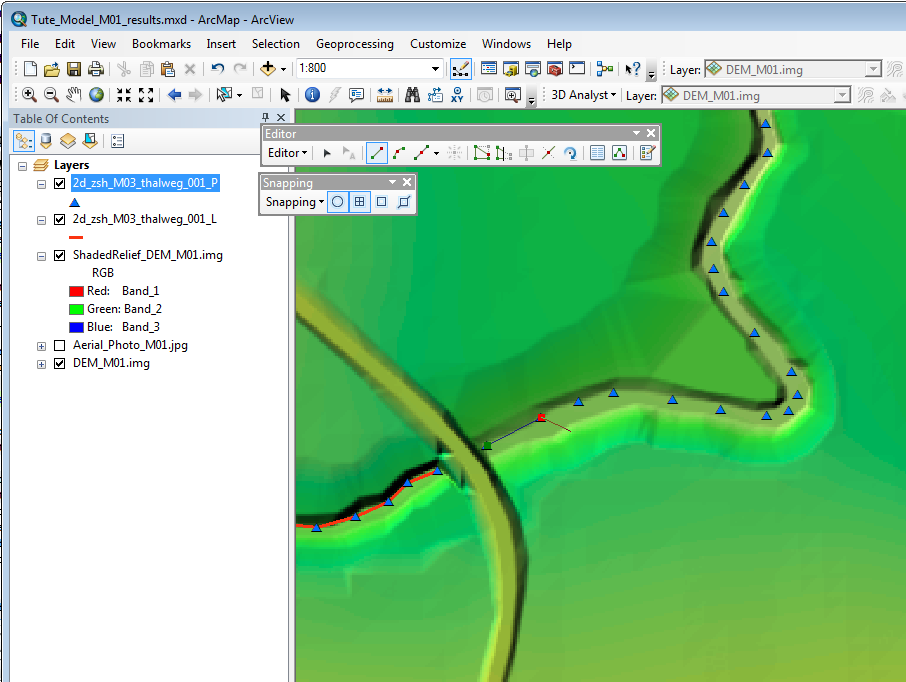
Conclusion
Two datasets have been imported into ArcMap and manipulated into a TUFLOW Z Shape format (2d_zsh). The next step is to modify the control files, please return to the module 3 page.